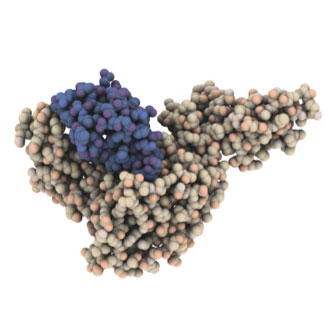Fighting back: Researchers develop new approach to weaken the ability of some viruses to evade the immune system
Middle East Respiratory Syndrome virus, Crimean Congo Hemorrhagic fever virus and a number of other viruses have the ability to block the immune system during infection, but a novel approach to fight back could soon be available.
“Emerging viruses pose a tremendous challenge to human health,” wrote University of Manitoba researchers in a recently published paper.
“While vaccine-based approaches are desirable in terms of infection prevention in the longer term, alternative antiviral strategies are needed, especially when providing treatment options for infected patients during acute outbreaks.”

The blue molecule is the ubiquitin variant and the brown/yellow molecule is the deubiquitinase from MERS coronavirus. The model was developed using images from the Canadian Light Source. // Image courtesy of Ben Bailey-Elkin
Led by Drs. Brian Mark, Marjolein Kikkert and Sachdev Sidhu, the researchers examined the three-dimensional structures of enzymes from two types of viruses using the Canadian Light Source.
They wanted to learn how the enzymes from the Middle East respiratory syndrome coronavirus (MERS) and Crimean-Congo hemorrhagic fever (CCHF) viruses are able to disarm human cells and prevent the cells from sending signals to the immune system to fight off infection.
A key component of cells that do this signaling is a molecule called ubiquitin, and enzymes from viruses that can block or disrupt the ubiquitin from functioning are called deubiquitinating enzymes.
The research team engineered a modified version of ubiquitin that could block the viruses’ deubiquitinating enzymes. While the culprit enzymes could be blocked in the lab, the researchers weren’t entirely sure how the engineered ubiquitin molecule was blocking the ability of the deubiquitinating enzymes to work.
“We wanted to know, at the atomic scale, how it was that we had blocked their function. And that’s what the CLS was able to provide us,” said Dr. Mark, a structural biologist at the University of Manitoba.
By seeing how the engineered ubiquitin actually blocks viral deubiquitinating enzymes, work can now begin to zero in on developing possible therapeutics against viruses that use these enzymes.
“The ability to be able to see something, right at the atomic level, will enable us to make further improvements to the (proteins) that we’ve generated. We now know precisely what’s important on the molecule, and what’s not important, meaning future drugs can be designed that are more precisely targeted,” he said.
While the findings can help in the quest for treatments for adenoviruses, herpes viruses, coronaviruses and others that use deubiquitinating enzymes, Dr. Mark notes that not all viruses use the same tools for protecting themselves against the immune system.






